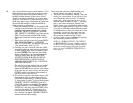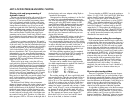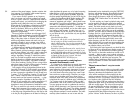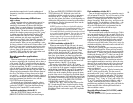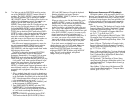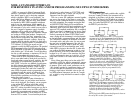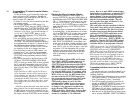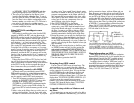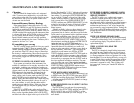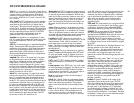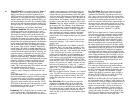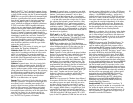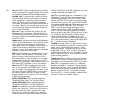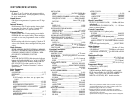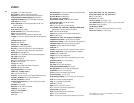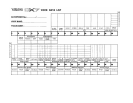MAINTENANCE AND TROUBLESHOOTING
Cleaning
The DX7 should be cleaned with a soft, moistened
cloth. To remove more stubborn dirt, use a mild deter-
gent solution on the cloth. Do not allow fluid to run into
the instrument, and do not use special cleaners since
solvents can mar the finish.
Internal Memory Battery Backup
If the internal battery voltage drops below 2.2 volts
(see [BATT CHECK] on page 20), the battery should be
replaced by an authorized Yamaha DX service center or
dealer. Make sure you have saved any internal voices on
a RAM cartridge before unplugging the instrument; there
is a chance the voices will be lost due to the low voltage
(or zero voltage while the battery is being changed).
Special lithium batteries are used, and this operation
should not be attempted by the owner. The battery life is
expected to be from 3 to 5 years.
If something goes wrong
The DX7 circuitry largely consists of a few very special
integrated circuits ("chips"). These are generally quite
reliable, although malfunctions can occur. If you do not
get sound out of the DX7, there is always a chance that
the circuitry is malfunctioning. More often, however, the
reason can be traced to something less drastic, like a
foot controller plugged into the VOLUME jack and set
for zero level.
IF THERE'S NO SOUND, OR ALMOST NONE
If you cannot get sound out of the instrument, first
recheck all connections to be sure they are made to the
proper jacks, including your amplifier and speaker sys-
tem. Make sure all equipment is turned on, and that the
volume controls are set at a reasonable level. Check the
DX7 to be sure its foot controller, if plugged into the
VOLUME jack, is tilted flat so there is at least some
output volume, and, of course, make sure the DX7 front
panel VOLUME control is pushed up. If you still hear
nothing, unplug the cable from the DX7 output and plug
it into another instrument which is known to work, or
use a test oscillator, to verify that the cables and the
sound system are indeed working. If they are, there are
still other reasons why you may not be getting sound
from the DX7.
If the DX7 is in EDIT mode, make sure that all the
operators are turned ON by selecting a parameter which
shows you the algorithm number (such as [EG RATE])
and then look at the six digits in the top row of the LCD
display They should be "111111" indicating all operators
are turned ON. If there are zeros, that may be why you
hear nothing. Try pressing the [EDIT/COMPARE] but-
ton to get to the "original" voice and see if the sound
returns. Another possibility is that the operator output
level is turned down. Press [OPERATOR OUTPUT
LEVEL] and then press [OPERATOR SELECT] to look
at the level of at least the carriers. If the level is below
30, there will be almost no sound; try 99 and see if
things improve.
Another possibility is that you have selected a voice
which has a lot of amplitude modulation sensitivity
programmed into its carriers, and that one of the modu-
lation controls is programmed with a significant amount
of amplitude modulation range. Lets say for example,
that the voice you are trying to play has its carriers set
for an [MOD SENSITIVITY-AMPLITUDE] value of 3
(the maximum), and that the keyboard AFTER TOUCH
section has been set, in FUNCTION mode, to a
[RANGE] of 99 and that the [AMPLITUDE] is ON. This
means that there will be absolutely no sound at all
when you play notes unless you begin to press hard on
the keys after they "bottom out". You can remedy the
situation by several means: turn OFF the AFTER
TOUCH amplitude response in the FUNCTION mode or
reduce the RANGE for that parameter, select a different
voice which does not have as much amplitude modula-
tion sensitivity or reprogram the voice in EDIT mode to
have less amplitude modulation sensitivity The same
type of problem can occur if the voice has amplitude
modulation sensitivity and the DX7 BREATH CONTROL,
FOOT CONTROL or MOD WHEEL sections are pro-
grammed (from FUNCTION mode) to have an extreme
amount of amplitude modulation range.
IF THE KEYBOARD IS MONOPHONIC
The problem may simply be that the instrument is set
to MONO mode. Press [FUNCTION] then press [POLY/
MONO] and see if the display shows "MONO MODE"
— if it does, use the [DATA ENTRY] controls to change
to "POLY MODE."
IF THE PITCH WHEEL HAS NO EFFECT OR TOO
LITTLE RANGE
The PITCH Wheel can and must be programmed to
be effective. Press [FUNCTION] and then press [PITCH
BEND- RANGE] and use [DATA ENTRY] to set the
range to whatever maximum you wish. See page 17 for
more details.
IF THE DISPLAY SHOWS "GARBAGE", LOCKS
UP, OR SOME OTHER FUNCTION REFUSES TO
OPERATE PROPERLY
The DX7 is really a very sophisticated computer.
Sometimes a random power surge or static spark —
even a powerful single cosmic ray believe it or not —
can temporarily destroy information in a digital memory
When this occurs, the results are unpredictable. Such
malfunctions are known as "soft" errors because they
are not caused by actual component failure. Turning the
DX7 power switch OFF waiting a half minute, and then
turning the power back ON will usually clear this type of
"soft" malfunction.
IF THE LCD WINDOW REMAINS DARK
The Liquid Crystal Display (LCD) can be permanently
damaged by extreme heat or cold. A symptom is a dark
or non-operating display This problem calls for a
replacement display
WHEN ALL ELSE FAILS, READ THE
INSTRUCTIONS
The DX7 is a deceptively simple looking instrument,
one which has many functions that are not obvious at
first glance. We realize this is a long manual, and there
is a strong temptation to skim over portions of it or skip
them altogether. If you are having difficulty, we urge you
to spend a little time re-reading the appropriate sections
of this manual to make sure you understand how the
instrument is supposed to work. Then, if things still
don't seem right, contact your Yamaha DX dealer for
assistance.
58



